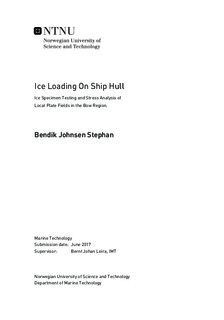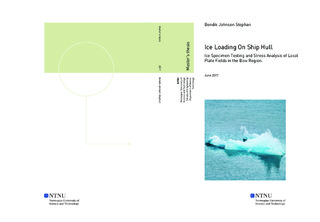| dc.description.abstract | Arctic operations are mostly carried out in seas covered in ice. For these operations, both DNV GL and IACS provide regulations for classification of ships. Interaction with ice is difficult to determine, as it could occur in many different ways. The ice vary both spatial and temporal, hence each individual interaction are distinct. The strength of sea ice depends on; ice temperature, porosity, salinity, and load direction.
The main scope of this Master s thesis is to study the behaviour of two plate fields located in the bow region of ice-going vessels, applying measurements of sea ice for load prediction. Uni-axial compression tests and parametric measures have been conducted by UNIS and prediction of ice loads are discussed in papers by Leira et al. (2009), Løset et al. (2006) and Riska (2011).
This Master s thesis presents sea ice theory down to a molecular level. Applying both theory and measurements, the flexural strength of both level ice and ridged ice were predicted. Further, the flexural strengths were applied in estimation of empirical contact pressures. These pressures were compared to pressures obtained from regulations provided by DNV GL and IACS, by conducting an assessment of a local plate field in the bow region. The assessment of the local plate field proved the dimensioning based on regulations to be a minimum requirement. The findings stated that regulations from DNV GL in general provide less contact pressure than similar regulations from IACS. Additionally, it was found that the empirical contact pressure model was able to give a simplified estimate of one interaction with ice, as ice have large temporal and spatial variations.
For the plate model located in the stem area, an empirical ridge ice pressure was applied and the boundary conditions were assessed. The model applied one fixed and three spring modelled boundaries. Findings from the assessment indicated the spring-modelled boundary to approach the behaviour of a fixed condition, as the spring stiffness was increased. Further, the modelling of the boundaries was only able to account for warping of the supportive frames.
Both models suffered from large permanent deformations and entered the non-linear behaviour region, as the applied pressures had a high magnitude. Additionally, the stiffeners providing support for the plates suffered from both plastic hinges and warping. | |

